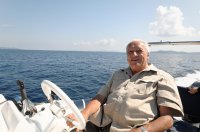General rules for props:
switch from aluminum to SS (all dimensions are the same) should drop WOT RPM by ~100
an increase in diameter of 1/4 inch should drop WOT RPM by ~100
an increase in pitch of 1 inch should drop WOT RPM by ~150 (range is 100 to 200)
3-blade vs 4-blade
4 blade props have some advanteges over 3 blade. If you have like material, then 4 blades promote stern lift, give better mid range fuel econ, slower top speed, better holeshot, are more balanced and dont vibrate as much and allow you to mount your engine higher due to more blade surface area in the water.
Generally, the heavier the boat the more blade surface area you want, not more pitch. So, rather than going up in pitch, go up in diameter or number of blades or a combination of the 2. This promotes less slippage, but costs you top end. Make the boat more efficient in cruise rpm range.
These are REAL general. You must consider that manufacturer A's prop might have identical dimensions as manufacturer B's prop, but there will be a large difference in WOT RPM's. This is usually due to the variation of blade width, cup, hub flare... There are many things that can cause a difference.
The other thing that could cause such a difference is the current at the time of your test. Maybe if you were able to run the other direction with the props in question, you would see a speed decrease of 5 mph. This would make your average lower and affect your calculations. With out the second pass, you shouldn't count the data. unless you can compare the one way pass with these props to the same direction one way passes with all the other props. Then the comparisons would be level.
perso.orange.fr/roland.barre 
